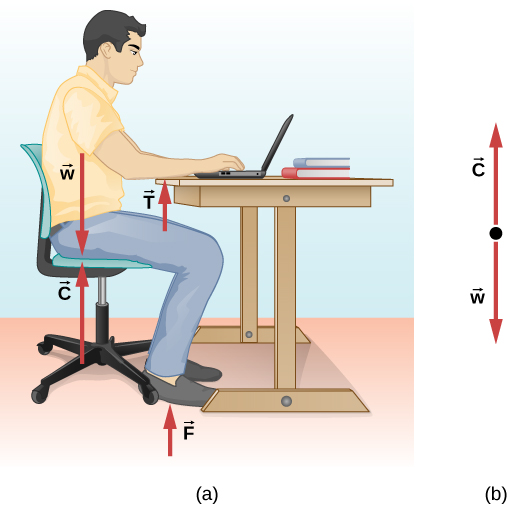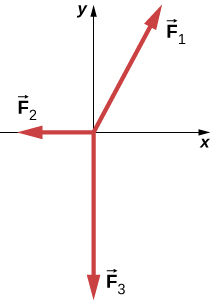| << Chapter < Page | Chapter >> Page > |
Let’s analyze force more deeply. Suppose a physics student sits at a table, working diligently on his homework ( [link] ). What external forces act on him? Can we determine the origin of these forces?

In most situations, forces are grouped into two categories: contact forces and field forces . As you might guess, contact forces are due to direct physical contact between objects. For example, the student in [link] experiences the contact forces , , and , which are exerted by the chair on his posterior, the floor on his feet, and the table on his forearms, respectively. Field forces, however, act without the necessity of physical contact between objects. They depend on the presence of a “field” in the region of space surrounding the body under consideration. Since the student is in Earth’s gravitational field, he feels a gravitational force ; in other words, he has weight.
You can think of a field as a property of space that is detectable by the forces it exerts. Scientists think there are only four fundamental force fields in nature. These are the gravitational, electromagnetic, strong nuclear, and weak fields (we consider these four forces in nature later in this text). As noted for in [link] , the gravitational field is responsible for the weight of a body. The forces of the electromagnetic field include those of static electricity and magnetism; they are also responsible for the attraction among atoms in bulk matter. Both the strong nuclear and the weak force fields are effective only over distances roughly equal to a length of scale no larger than an atomic nucleus ( ). Their range is so small that neither field has influence in the macroscopic world of Newtonian mechanics.
Contact forces are fundamentally electromagnetic. While the elbow of the student in [link] is in contact with the tabletop, the atomic charges in his skin interact electromagnetically with the charges in the surface of the table. The net (total) result is the force . Similarly, when adhesive tape sticks to a piece of paper, the atoms of the tape are intermingled with those of the paper to cause a net electromagnetic force between the two objects. However, in the context of Newtonian mechanics, the electromagnetic origin of contact forces is not an important concern.
As previously discussed, force is a vector; it has both magnitude and direction. The SI unit of force is called the newton (abbreviated N), and 1 N is the force needed to accelerate an object with a mass of 1 kg at a rate of : An easy way to remember the size of a newton is to imagine holding a small apple; it has a weight of about 1 N.
We can thus describe a two-dimensional force in the form (the unit vectors indicate the direction of these forces along the x -axis and the y -axis, respectively) and a three-dimensional force in the form In [link] , let’s suppose that ice skater 1, on the left side of the figure, pushes horizontally with a force of 30.0 N to the right; we represent this as Similarly, if ice skater 2 pushes with a force of 40.0 N in the positive vertical direction shown, we would write The resultant of the two forces causes a mass to accelerate—in this case, the third ice skater. This resultant is called the net external force and is found by taking the vector sum of all external forces acting on an object or system (thus, we can also represent net external force as ):
This equation can be extended to any number of forces.
In this example, we have . The hypotenuse of the triangle shown in [link] is the resultant force, or net force. It is a vector. To find its magnitude (the size of the vector, without regard to direction), we use the rule given in Vectors , taking the square root of the sum of the squares of the components:
The direction is given by
measured from the positive x -axis, as shown in the free-body diagram in [link] (b).
Let’s suppose the ice skaters now push the third ice skater with and . What is the resultant of these two forces? We must recognize that force is a vector; therefore, we must add using the rules for vector addition:
Check Your Understanding Find the magnitude and direction of the net force in the ice skater example just given.
14 N, measured from the positive x -axis
View this interactive simulation to learn how to add vectors. Drag vectors onto a graph, change their length and angle, and sum them together. The magnitude, angle, and components of each vector can be displayed in several formats.
What properties do forces have that allow us to classify them as vectors?
Forces are directional and have magnitude.
Two ropes are attached to a tree, and forces of and are applied. The forces are coplanar (in the same plane). (a) What is the resultant (net force) of these two force vectors? (b) Find the magnitude and direction of this net force.
a. ; b. the magnitude is , and the direction is
A telephone pole has three cables pulling as shown from above, with , , and . (a) Find the net force on the telephone pole in component form. (b) Find the magnitude and direction of this net force.

Two teenagers are pulling on ropes attached to a tree. The angle between the ropes is . David pulls with a force of 400.0 N and Stephanie pulls with a force of 300.0 N. (a) Find the component form of the net force. (b) Find the magnitude of the resultant (net) force on the tree and the angle it makes with David’s rope.
a. ; b. at from David’s rope

Notification Switch
Would you like to follow the 'University physics volume 1' conversation and receive update notifications?